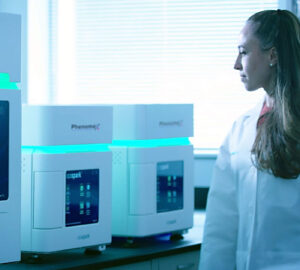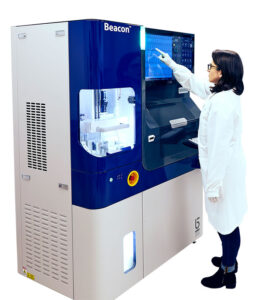In the biopharma industry, the greatest achievements occur when inspiring science is paired with enabling technology. To better contribute to such achievements, two providers of innovative tools and instruments—Berkeley Lights and IsoPlexis—are joining forces. Specifically, Berkeley Lights has acquired IsoPlexis to form PhenomeX. The new company intends to broaden the scope of functional biology experiments by bringing together two key technologies: proteomic barcoding (assessing functional phenotypes of individual cells) and optofluidics (moving cells without physical contact).

“One of the two companies had expertise in analyzing 35 to 40 different variables for each cell. The other focused on keeping the cells alive, moving them, studying them in parallel, and growing them in nanoliter-sized chambers,” says Siddhartha Kadia, PhD, CEO of PhenomeX. Their combination, therefore, is a natural fit that expands scientific capabilities for customers while generating economies of scale for the new company itself.
“In most biological experiments, scientists manipulate cells with a pipette or some other physical method that actually touches the cell,” Kadia adds, “but in our case, the only thing moving the cells is light.” This no-contact cell manipulation, called opto-electropositioning (or OEP®) technology, lets scientists guide cells into specific locations, known as Nanopen® chambers. Then the scientists can culture and assay the cells for multiple functional characteristics, even when massively parallel experiments are being conducted. One hundred thousand Nanopen chambers are the equivalent of 1 well in a 386-well plate.
Because this light-based technology keeps cells alive, unlike many technologies for cell-based studies, it expands their use in discovery and as biological factories to make proteins, antibodies, or viruses. Kadia points out that the technology helped the Vanderbilt Vaccine Center find the only COVID-19 antibodies used for preexposure prophylaxis and prevention of COVID-19.
Unique positioning
PhenomeX leverages significant advances in information sciences, material sciences, and biological sciences. As a result, the company is, in Kadia’s view, “the only single-cell platform able to isolate, manipulate, and characterize live cells while enabling large-scale and multiplexed functional proteomics.” The instruments PhenomeX sells fall into two main price ranges: either $1–2 million, or $100,000–200,000.
“We are in a uniquely advantageous situation in that cell biology has not been a focus of some of these large conglomerates until recently,”
Kadia notes. “There are not many competitors. This is one area of science that is quite open for a lot of players to participate.”
That doesn’t mean growth is easy, of course. Berkeley Lights and IsoPlexis were each about a decade old—relatively young among instrument developers—and in the early stages of commercialization before being combined. The two have sold some 400 instrument platforms in total. Now, as PhenomeX, the leadership is working to ensure commercial processes are in place and that the technologies are available throughout the world. Most of the manufacturing will occur in the United States.
Likely customers
Kadia describes PhenomeX customers as biotechnology and pharmaceutical companies; contract research organizations and contract development and manufacturing organizations; and academic research institutions and translational medical centers. Applications for PhenomeX’s technology fall into four categories: antibody discovery, cell line development, cell therapy development, and gene therapy development.
“[Cell therapy and T-cell receptor discovery are] extremely important for immuno-oncology and all sorts of immune system disorders,”
Kadia emphasizes. “We understand now that the immune system can go haywire in many different cases, and the technology is available to study the diversity and efficacy of T-cell receptors and related molecules, such as chimeric antigen receptors.”
Gene therapy development applications often involve contract development and manufacturing organizations. Currently, genes are most commonly introduced into cells using modified adeno-associated viruses (AAVs), but producing them can be cost prohibitive. Developing stable cell lines to produce AAVs will significantly expand the number of diseases that can be treated using gene therapies. “PhenomeX has a solution to identify stable, AAV-producing cell lines amongst thousands of cells, after you introduce your gene of interest,” Kadia tells GEN.
Enhancements and efficiencies
“By bringing these two companies together, we are able to combine the hardware and the software [elements of development],” Kadia points out. That offers the potential, from an engineering perspective, to introduce enhancements and efficiencies into the instruments once they are deployed at customer sites.

PhenomeX engineers, therefore, ask fundamental questions about what biologists using these instruments want and need. That’s often an easy-to-use instrument that requires minimal training. “If you keep simplicity in mind,” Kadia notes, “you can make lower-cost devices possible.”
The merger is expected to deliver some $70 million in cost savings to the new company, largely by eliminating duplicative costs associated with maintaining the infrastructure needed by public companies. The combined companies also benefit by consolidating their sales and marketing teams. According to Kadia, PhenomeX will be able to put “a lot more commercial resources in front of our customers.”
In 2022, before the merger, the companies generated some $95 million. Also, by then, the companies had amassed more than 600 patents. Current projections call for PhenomeX to break even by Q4 2024.
Functional questions
To drive the biological revolution, scientists need the right tools. For example, even though the structure of DNA was deciphered in the early 1950s, it wasn’t until the discovery and characterization of restriction enzymes in the late 1960s and early 1970s that scientists were able to study the genome in small pieces. Then, in the early 1980s, polymerase chain reactions were introduced, making the genomics revolution possible.
“A lot of what I think has been lost in the excitement surrounding genomics is the true nature of the quest for biology … which always has to do with the function of any organism or unit,” Kadia insists. The unit most relevant to PhenomeX is the cell. Even the company’s ticker symbol is CELL.
“Cells are complete biologically functioning organisms, and understanding how they actually function has been the longstanding goal of biologists,” Kadia continues. “Genomics and proteomics serve extremely important functions in what biologists do, but at the end of the day, the data they provide are surrogates for the sorts of questions scientists really care about: What does this cell do? Why is this tumor cell resistant to chemotherapy?”
Developing the tools to answer such questions was the mission of both IsoPlexis and Berkeley Lights, and it is the ongoing mission of PhenomeX.
Kadia’s short-term focus is integrating the teams from Berkeley Lights and IsoPlexis and making PhenomeX successful. Longer-term, however, Kadia sees opportunities.
“The marketplace is undergoing a tremendous amount of change … and the era of affordable money is over,” he tells GEN. “We believe we could be an attractive platform for consolidating other cell-based technologies, enabling tools, and other fantastic technologies into our portfolio … with the vision of becoming a broad cell-based company.”

